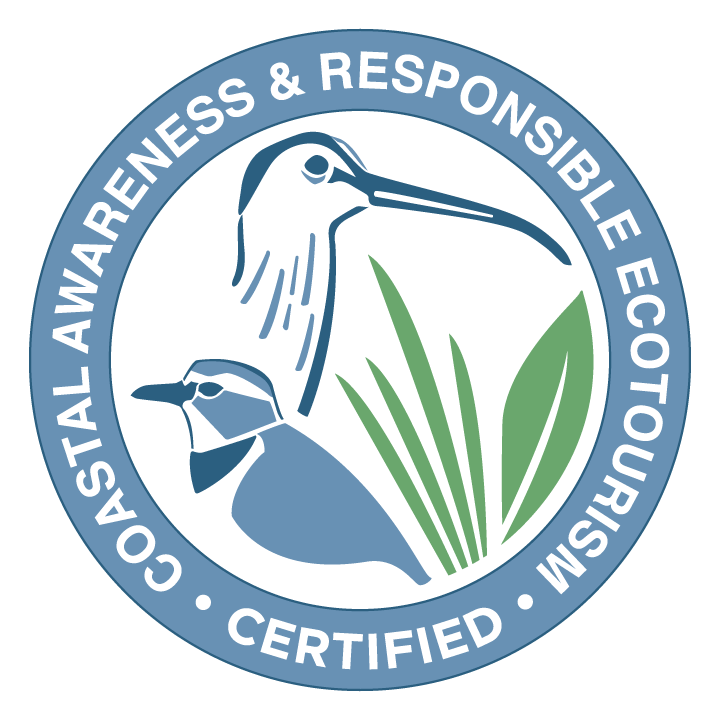Shellfish Aquaculture and Oyster Reef Restoration

Key Concepts:
- Restoration
- Research
- Commercial shellfish production
- Shellfish Research Laboratory (Virtual Tour)
Shellfish aquaculture provides multiple social, economic and ecological benefits. Socially, aquaculture is a place-based occupation and jobs are tied to the water around them, providing household stability that depends on environmental stewardship of the local area, which in turn benefits the local economy and community. Because successful aquaculture projects need clean water, activities are usually situated in more rural areas, and can bring jobs and infrastructure. (Fatunla, 1996). Aquaculture provide economic benefits. The Economic Impact Forecast Analysis on oyster aquaculture conducted in 2020 by UGA MAREX-SG indicates that five 1-million oyster farms could provide 35 jobs and generate 1.38 million in labor income and 2.73 million in sales annually in Georgia over a five year period. Additionally, aquaculture provides many benefits ecologically. The eastern oyster is a filter feeding mollusk, pulling in water and filtering out food from the surrounding water. Through this process, oysters remove or reduce the amount of organic matter, nutrients, silt, bacteria and viruses in the water, and increase water clarity. Clearer water results in better habitat for submerged vegetation, providing cover for countless species. (Shumway, et al. 2003) Oysters can filter up to 100 gallons of seawater in a single day as part of their natural feeding process and are a critical part of the structure and habitat of the saltwater marsh. In addition, oysters are an important indicator of water quality and tell a story about the health of the surrounding coastal ecosystem. According to NOAA (National Oceanic and Atmospheric Administration, (https://www.fisheries.noaa.gov/feature-story/aquaculture-supports-sustainable-earth) sustainable aquaculture improves local waterways, increases seafood production, creates economic opportunities, advances technology, provides health benefits, preserves cultural heritage and provides opportunities for aquaculture partnerships.
Restoration
Several collaborative oyster reef restoration initiatives by the UGA Marine Extension and Georgia Sea Grant, the Coastal Resources Division of GADNR (CRD), Sapelo Island National Estuarine Research Reserve (SINERR) and other organizations have successfully improved water quality and marine health in designated areas:

Georgia’s oyster populations were once immense but over-fishing, habitat degradation and disease have considerably impacted these estuarine communities. Intertidal oysters are described as a “keystone” species for the critical role they play in maintaining a healthy coastal ecosystem. Dense populations of oysters can significantly improve water clarity and quality by filtering algae and pollutants. These reefs also provide a hard substrate in the otherwise soft, muddy substrates of Georgia’s estuaries for oyster larvae and other organisms to settle, attach and grow. Intertidal reefs provide spawning, breeding, feeding and nursery habitat for many commercial, recreational and sport species that are ecologically important to the region. Georgia has approximately one-third of the remaining coastal salt marshes on the East Coast of the United States. Intertidal reefs protect these marshes against shoreline erosion by dissipating the energy caused by boat wakes and waves. Oysters are also an important food source for humans and many other animals.
UGA Marine Extension and Georgia Sea Grant coordinate a community-based oyster restoration project called G.E.O.R.G.I.A. where recycled oyster shell are used to create new oyster reefs. This project helps build public awareness of the importance of oyster reef habitat along the Georgia coast. Oyster shell is collected from restaurants and private oyster roasts and taken to a collection center. Volunteers prepare the cured oyster shells for construction of oyster reef substrate using a variety of methods including bagging shell for placement along streams to provide appropriate substrate for natural oyster settlement.
How can you get involved? Donate the shell from your oyster roasts:
Are you planning a private oyster roast? Do you own a seafood restaurant that serves oysters? Donate your shell to the G.E.O.R.G.I.A. program. Call UGA Marine Extension and Georgia Sea Grant to have our staff organize a shell collection. Alternatively, you can drop off shell at one of the recycling centers in Savannah, Brunswick and Jekyll Island.
Contact: Tom Bliss,
Director, Shellfish Research Lab
Phone: 912.598.2348 ext: 205
Email:tbliss@uga.edu
Oyster reef building and enhancement takes place during the spring months as volunteers move the mesh bags of cured oyster shell to selected oyster reef sites. Bagged oyster shell creates a substrate for oyster larvae to settle, attach and grow during the spawning season, as well as a providing a habitat for other organisms.
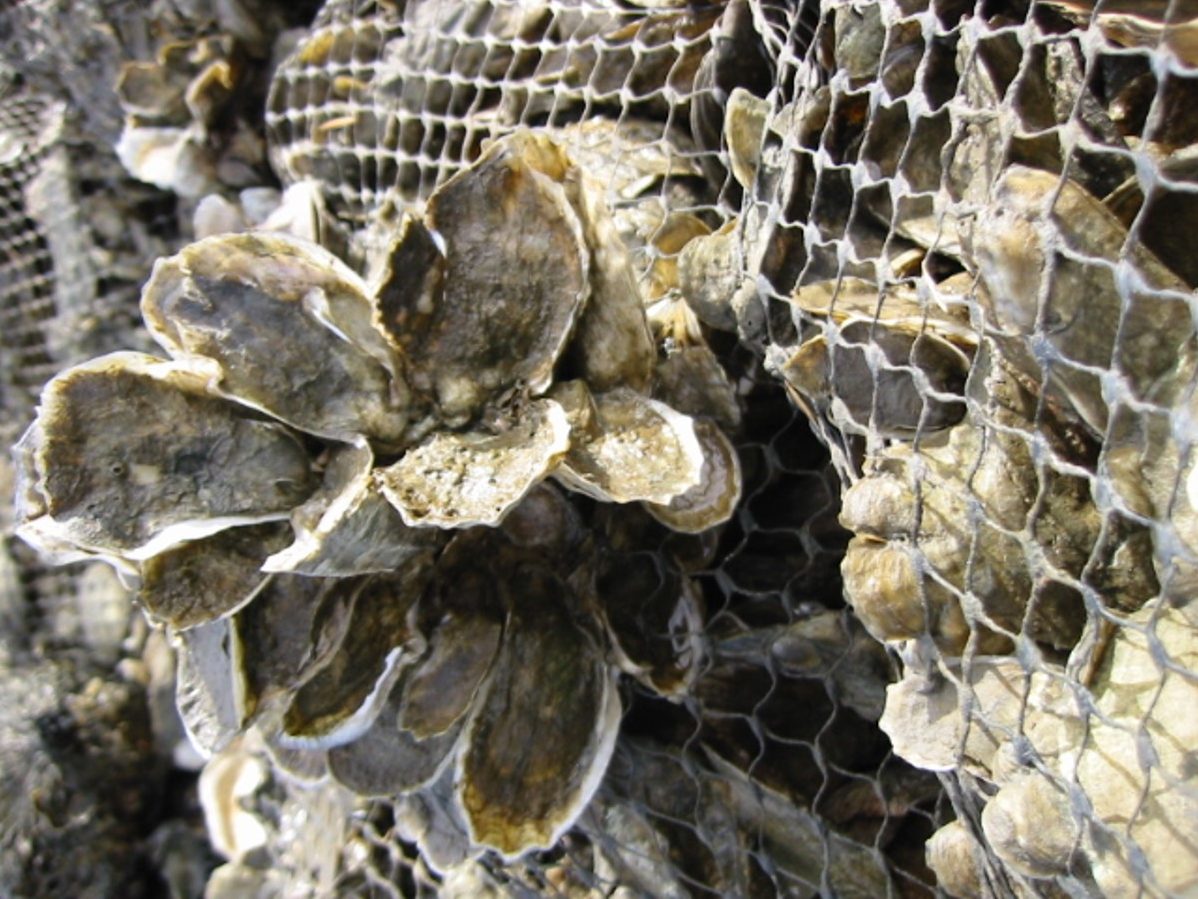


Beach Creek, Jekyll Island is the site of a successful bioremediation project that worked to increase the shellfish population and filter out bacterial contaminants. The G.E.O.R.G.I.A project provided an opportunity to increase the shellfish population and filter out excessive bacteria in the creek. The project successfully raised awareness and served as a tool to educate the community about local water quality issues.
Oyster mapping is another project designed to support oyster reef habitats. Mapping determines the location and acreage of live oyster reefs and works to aid in conservation and resource management of reefs along the coast. Through geographic information systems (GIS), researchers can survey the distribution of oyster reefs along the Georgia coastline and establish the optimum sites to create newly restored oyster habitat. These results assist restoration projects by providing baseline data about habitat conditions and distributions at each location. Data from GIS and handheld GPS also helps researchers monitor water quality, assess the geography of shorelines and plan management strategies for the future of coastal resources.
Living Shorelines
Traditional shoreline protection uses seawalls and bulkheads that “harden” the shore and cause a break between the marsh and upland. These structures protect the land for a time but must be maintained and replaced over time.
Living shorelines mimic nature to stabilize marsh banks by using native plants and oyster shells. Tides are constantly changing, and a living shoreline works with the natural environment to stabilize the shoreline and allows the marsh and upland to remain connected.
UGA Marine Extension and Georgia Sea Grant are working with the Georgia Department of Natural Resources (GA DNR), The Nature Conservancy, Sapelo Island National Estuarine Research Reserve (SINEER) and Little St. Simons Island, LLC to study living shorelines as an alternative way to protect property and provide habitat for marine life and wildlife. Three project sites are being studied: two located at SINEER and one on Little St. Simons Island.
Sapelo Island Project The projects on Sapelo were funded by the Georgia Department of Natural Resources and SINEER. The sites were established in the spring of 2010 with the goal of stabilizing areas where the stream bank was eroding.
Little St. Simons Island Project UGA Marine Extension and Georgia Sea Grant, in partnership with GA DNR Coastal Resources Division, The Nature Conservancy, Sapelo Island National Estuarine Research Reserve and Little St. Simons Island, LLC, established a living shoreline on Little St. Simons Island. The project was funded in part by a grant from the Southeast Aquatic Resources Partnership NOAA Community Based Restoration Grant Program and by Little St. Simons Island, LLC.
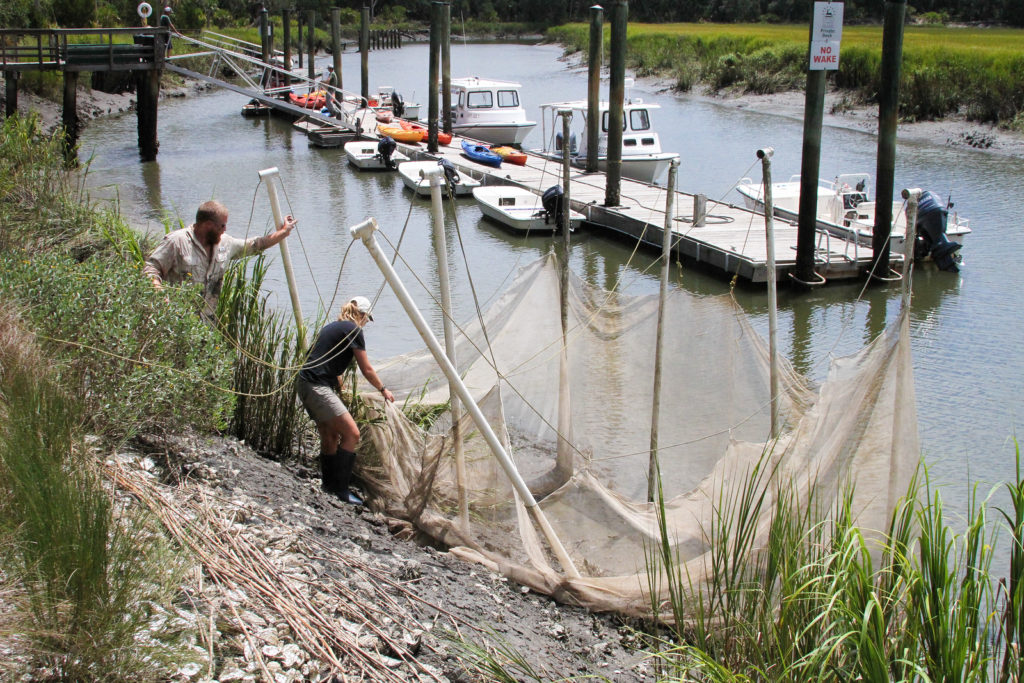
The project goal is to remove a failing bulkhead and use oyster shells to stabilize the creek bank. This is the second living shoreline constructed using oyster shells in Georgia and will continue to be monitored to determine if the living shoreline technology will be a viable alternative to traditional shoreline hardening methods such as bulkheads and rip-rap. Once completed, we will have established ~0.1 acres of oyster habitat and planted ~2,000 native plants at the site.
To help establish the living shoreline an Americorp National Civilian Community Corps team, Delta 7, is helping bag oyster shells and plant marsh plants that are vital to the success of the living shoreline.
Tybee Island Project UGA Marine Extension and Georgia Sea Grant completed the construction and installation of the base layer for a living shoreline project at the Burton 4-H center on Tybee Island, a project partially funded by a National Fish and Wildlife Foundation grant. The goals of this project are to stabilize an eroding bank at the Burton 4-H center and increase the amount of oyster and marsh habitat in Horse Pen Creek.
The Tybee Island project partners include UGA Marine Extension and Georgia Sea Grant, the UGA Carl Vinson Institute of Government and Georgia 4-H. The City of Tybee, Chatham County Metropolitan Planning Commission, Coastal Civil Engineering, 100 Miles and The Nature Conservancy all provide additional support for the project.
Research
Investigating disease causing pathogens, enhancing best management practices, and potential policy barriers for the success of oyster aquaculture in Georgia are all areas of ongoing, oyster-related research. The Shellfish Research Laboratory and collaborating institutions are actively involved in applied research serving Georgia’s Coast. Some examples of current research are detailed below.
Disease causing pathogens-Vibrio Vibrio parahaemolyticus (Vp) and Vibrio vulnificus (Vv) are natural bacteria found in brackish and saltwater environments. When Vp are in high concentration in shellfish, such as oysters, they can cause Vibrio illness when eaten raw. Therefore, to safeguard human health, the FDA requires each state that allows the harvest of shellfish to have a Vibrio control plan established. The state of Georgia’s current Vibrio plan is to close oyster harvest when water temperatures are above 81°F. When water temperatures are below 81°F Vibrio levels are considered by the FDA to be at a safe level and are classified as a “non-Vibrio control month.” Shellfish harvest in Georgia takes place generally October-May. Whereas harvest is generally closed in the months when water temperatures are expected to reach exceed 81°F, June-September.
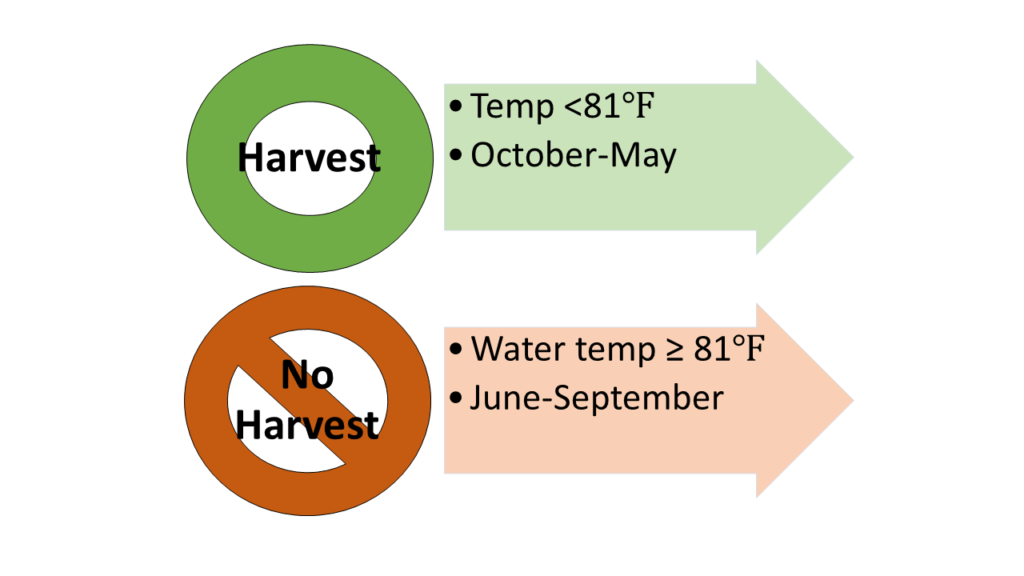
With recent passing of legislation to allow aquaculture in Georgia waters, a new “closed season” harvest requires an additional Vibrio control method to ensure that harvest methods keep Vibrio levels at a safe level even when water temperatures are above the 81°F threshold.
The states of South Carolina and Florida have established “closed season” harvest methods which the Shellfish Research Lab and collaborators plan to evaluate in Georgia waters including the collection of baseline (naturally occurring) Vibrio levels to determine which method will be best for Georgia. To evaluate current Vibrio levels a sampling location in Mud River in McIntosh County has been established. Four floating cages (such as those pictured below), that hold six bags each and 24 floating bags are suspended in the water column using foam floats. Bags will be stocked at density of 100 oysters bag. Oysters were set out in May 2022 to acclimate to the area.
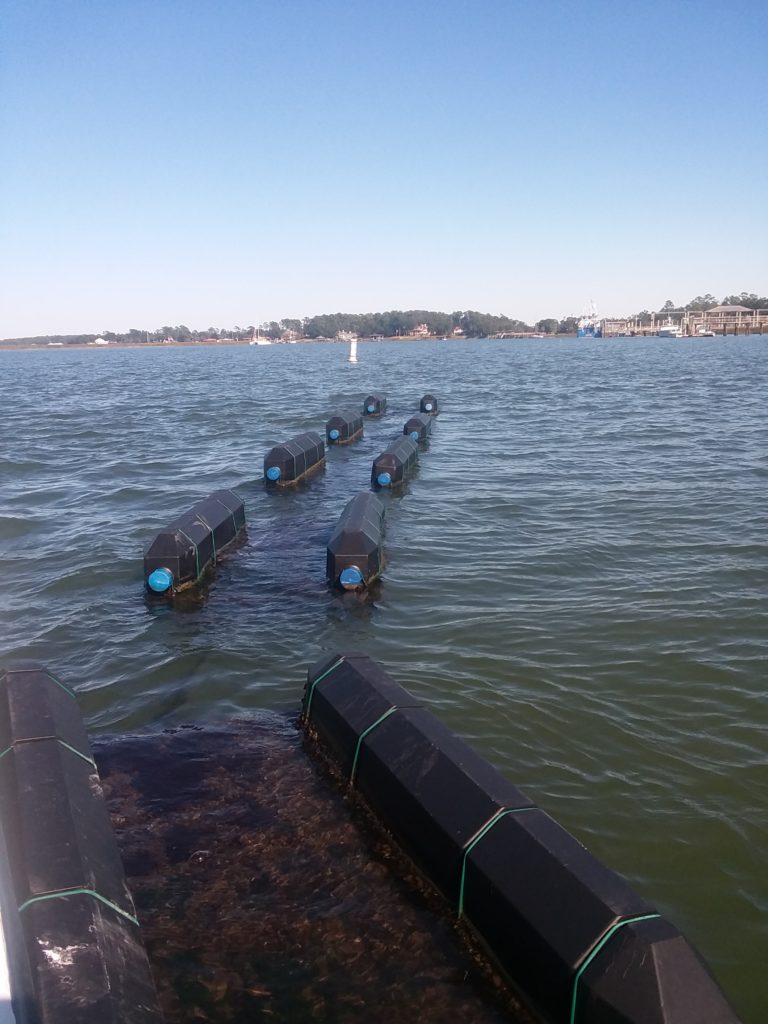
Starting June 2022, oysters are collected twice a month through October 2022 for analysis. Three samples (15 oysters/sample) are collected to estimate baseline values from floating cages and floating bags. Three samples (15 oyster/sample) are harvested from floating cages and floating bags. Ten to twelve of the oysters from each sample are processed for vibrio using the three-tube-most-probable-number (MPN) method (to test for metabolic signs of the organism) and real-time PCR (to test for genetic traces of Vibrio) the other three are used to measure internal temperature and track oyster temperature (Jones et al. 2020). In addition to collecting oysters, environmental conditions (air temp, weather, water temperature, salinity, dissolved oxygen, and pH) when samples are pulled are collected. All vibrio testing is being conducted by Erin Lipp with UGA College of Public Health at her lab in Athens.

Southern clam study The southern quahog (Mercenaria campechiensis) is a large clam in the Venus clam family and is distributed from the Chesapeake Bay to Florida and west to the Yucatán Peninsula. It co-occurs with the northern quahog (Mercenaria mercenaria ) throughout the southern range of the species where hybridization between the two occurs. In Georgia there is commercial interest in the culture of southern quahogs within the state to reduce heat losses observed (>50% at some sites July-September) with northern quahog culture. Southern quahogs have higher growth and survival rates than northern quahogs at warmer water temperatures. Use of southern quahogs by Georgia clam farmers may offset summer losses observed with northern quahogs in the south resulting in measurable gains in clam production within the state. The proposed research evaluates survival, growth, meat condition, estimated biomass, and harvest between clam species planted at each of three commercial sites in Georgia. Clams will be deployed and cultured in soft mesh nylon clam bags and farmed using methodology consistent with commercial clam farms in the southeast. Data will be collected and analyzed quarterly over a two-year period (September 2021-August 2023).
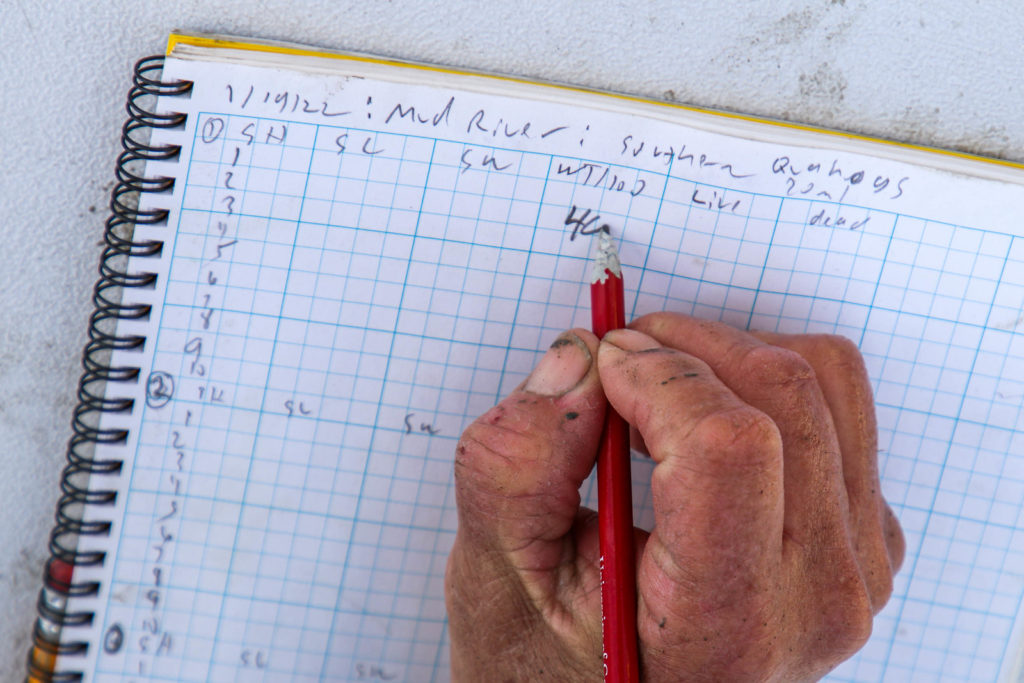
Portable hatchery Oyster Seed Holdings Company (OSH) developed three portable hatcheries to help address oyster seed production with funding from Phase 2 Small Business Innovation Research (SBIR) award from the USDA. The Shellfish Research Laboratory is operating one of hatcheries to determine production ability.
Nearly every oyster consumed in the United States began in a shellfish hatchery as what is called a “seed” oyster. In the earliest stages of an oyster’s life, it is microscopic and at the mercy of local environmental and water quality conditions that can change quickly, threatening production. Until now, hatcheries have been in fixed locations, where they must ride out unfavorable conditions.
To address this vulnerability, OSH has developed a scaled-down hatchery that fits into a standard 53-foot tractor trailer or container. As such, it is mobile. The mobile hatchery concept allows a more agile response to changing site conditions. It can also be a vehicle for testing the adequacy of building a hatchery in a new location.
Spat on Shell Oyster habitat restoration efforts are limited to the oyster reproductive season and require a timely deployment of oyster cultch (finely-ground oyster shell) to maximize oyster settlement and reduce the risk if siltation. A layer of sediment as thin as 2 mm is sufficient to render cultch completely unsuitable for recruiting oyster larvae (Smith 1949) however adult and post settlement oysters are adept at dealing with moderate sediment loads (Shumway 1996). The sediment deposition rates in coastal Georgia (Bahr and Lanier 1981) can quickly and unexpectedly hinder restoration attempts by smothering cultch prior to a natural recruitment event. Therefore, greater success may be observed by allowing restoration programs to organize and execute restoration projects with greater time, efficiency, and success via utilization of hatchery produced spat-on-shell set remotely. This would reduce timing pressure associated with seasonal cultch deployment and improve performance of restored oyster reef by pre-stocking them with juvenile oysters to kick start oyster reef development. This is a broadly implemented strategy along the contiguous coast of the U.S. (Brumbaugh and Coen 2009) and can be a foundational tool for Georgia’s resource managers in structurally buffering natural endemic oyster resources from environmental degradation and decline associated with development and other anthropogenic impacts.
The research will investigate restoration techniques that are of interest to the state inshore restoration program that contribute to increased ecosystem functioning by comparing traditional restoration techniques (loose shell) to more advanced techniques (loose spat-on-shell). Romerly Marsh Creek (Chatham County) and South Brunswick River (Glynn County) are ideal locations to trial the proposed strategy of oyster habitat restoration using spat-on-shell. Six treatment types will be included in the proposed research and will include: 1) spring loose spat-on-shell, 2) spring loose oyster shell – no spat, 3) spring spat on bagged shell, 4) spring bagged shell – no spat, 5) fall loose spat-on-shell, and 6) fall bagged spat-on-shell. Treatments one and two will be laid two layers thick and set out in April/May; treatment three and four, will be two bag layers deep and set out in late spring early summer, treatment five and treatment six fall spat-on-shell, will be laid out in September following same methodology used for treatments one and two. Treatments two and three will be used as the control at both sites. Treatments one through four will be deployed during the oyster reproductive season to maximize capture of additional natural oyster recruitment. Treatments five and six, the fall treatment, will be deployed outside of the conventional oyster reproductive season.
Commercial Production
History Oyster culture began taking place as early as 1830 in the Southeastern part of the United States. In 1880 it was estimated that 290,000 bushels of oysters were harvested and were valued at $115,000. Early in the 1900’s steam canneries grew in Georgia and South Carolina and by 1902 nearly 95% of the oyster catch was canned in Georgia and South Carolina. Oysters were gathered by pickers in the intertidal zones of SC and GA and taken to canneries. At the canneries the oysters’ shells were opened by steam and picked by hand. Oysters were placed in a tin can and sealed. This hard labor made it difficult to maintain employees over an extended period of time. By World War II many canneries closed due to labor shortages.
Poor yields, cheap imports, and labor shortages all led to the demise of the oyster canneries in the late 1980’s. At present time, the oyster production is at an all-time low because of closures of productive grounds due to pollution, lack of markets, labor shortages, coastal development, non-point source pollution, and run off from golf courses and residential areas. These factors have also affected other traditional shellfish harvests in the state of Georgia. The whelk fishery is also at an all-time low due to overfishing of the resource.
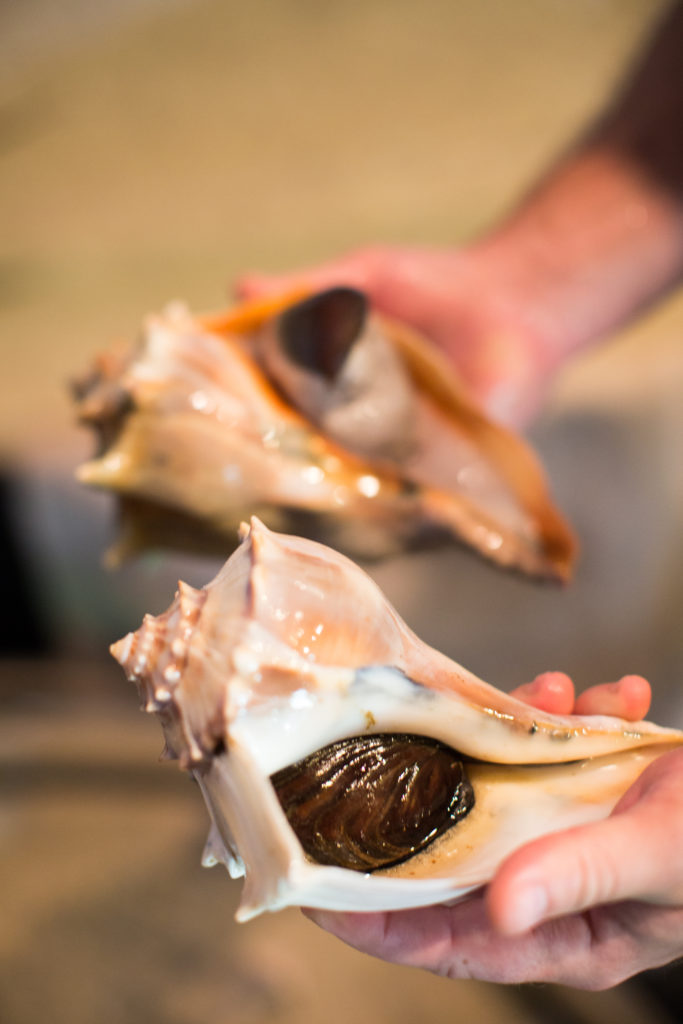
Aquaculture in Georgia is well established for inland finfish and freshwater prawns, but marine aquaculture in the State is still in its nascent stages. Clam farming in the State was worth $1.8 million dollars in 2019, but oyster farming has been slow to develop, due to past regulations and was valued at $76,500 in 2019 (GA CRD 2020). Recent changes to State regulations adopted in 2020, are allowing oyster aquaculture techniques to be utilized in Georgia.
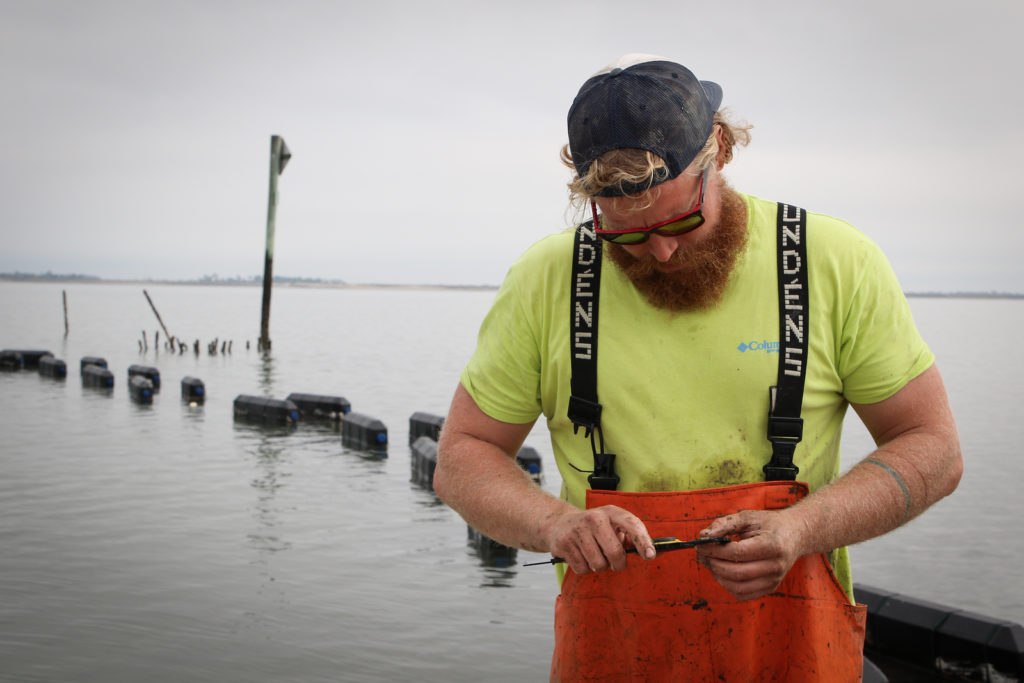
New legislation UGA Marine Extension and Georgia Sea Grant received funds from the Sea Grant Covid funding to provide training opportunities and raise awareness pertaining to Georgia seafood. A portion of that funding is being used to provide a Shellfish Aquaculture Training course. The training course was developed in partnership with North Carolina Sea Grant and South Carolina Sea Grant Consortium and Marine Extension and Georgia Sea Grant with NOAA Aquaculture funding. The training was led and piloted in North Carolina and is now being offered in Georgia. The training supports the efforts of the state of Georgia to expand shellfish aquaculture opportunities, and the training program will provide information on oyster and clam farming techniques, process for obtaining a shellfish lease, and best practices for business planning. The training is a 7-course program.
Shellfish Research Laboratory



The UGA Shellfish Research Laboratory (SRL) is a leader in the fields of shellfish aquaculture, biology and ecology through its research and development of fisheries management techniques. SRL contributes studies, training and new technology to support the development economically viable and environmentally friendly aquaculture industries.
The SRL Lab is home to the state’s first oyster hatchery, which launched in fall 2015. It is expected to produce between five and six million spat, or baby oysters, per year by 2018, which will be worth an estimated $1.6 million when harvested. The SRL strives to contribute significant knowledge to the development and promotion of environmentally friendly aquaculture industries, and is also available to assist citizens through the associated permitting, regulations and licensing process.
Researchers at the UGA Shellfish Research Lab are working with oyster farmers to study how best to grow single oysters better suited for eating on the half shell. the farmed oysters are the same species as the wild oysters but raised and handled in a way that produces a single oyster rather than a clump. From spawning to nursing the larvae to setting spat and feeding them appropriate algal cultures for each stage of development, the hatchery building is equipped to ready seed for potential Georgia shellfish growers.
Contact mared@uga.edu to schedule a service-learning opportunity with Marine Extension and Georgia Sea Grant Shellfish Research Lab and tour the facility.
References
Bahr, L. M., & Lanier, W. P. (1981). The ecology of intertidal oyster reefs of the South Atlantic coast: a community profile. The Team.
Brumbaugh, R. D., & Coen, L. D. (2009). Contemporary approaches for small-scale oyster reef restoration to address substrate versus recruitment limitation: a review and comments relevant for the Olympia oyster, Ostrea lurida Carpenter 1864. Journal of Shellfish Research, 28(1), 147-161.
Fatunla, G. 1996. Socio-economic issues in the education of children of migrant fishermen in Nigeria. Journal of Sustainable Agriculture 9(1):31–55.
GA CRD. 2020. Georgia Commercial Seafood Landings. Georgia Department of Natural Resources, Coastal Resources Division, Brunswick, GA. https://coastalgadnr.org/sites/default/files/crd/pdf/marfish/broadhis.pdf
Shumway, S.E., C. Davis, R. Downey, R. Karney, J. Kraeuter, J. Parsons, R. Rheault, and G. Wikfors. Shellfish Aquaculture – In Praise of Sustainable Economies and Environments (December 2003) World Aquaculture.
Smith, C. M., & Hackney, C. T. (1989). The effects of hydrocarbons on the setting of the American oyster, Crassostrea virginica, in intertidal habitats in southeastern North Carolina. Estuaries, 12(1), 42-48.
